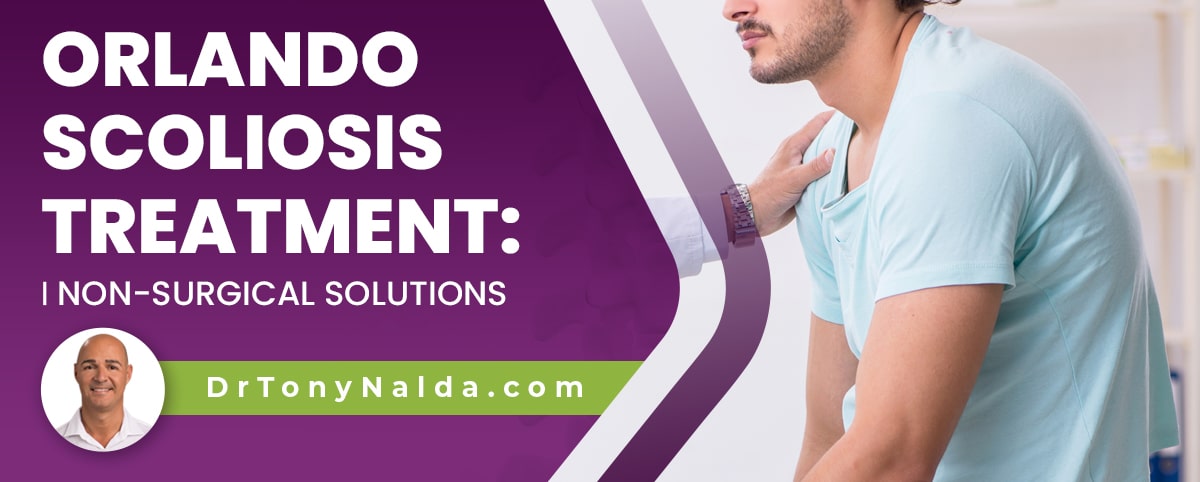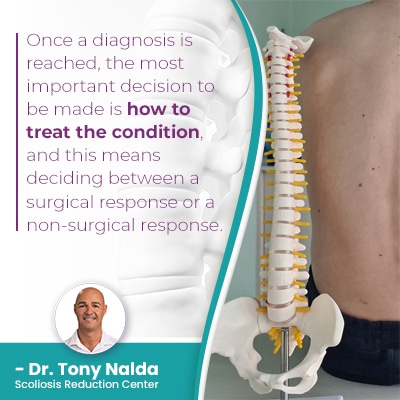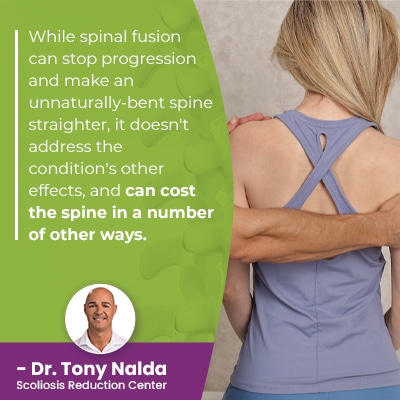Orlando Scoliosis Treatment: Non-Surgical Solutions

It's important that patients understand both the progressive nature of scoliosis, and how different types of treatment can affect the spine differently. When it comes time to commit to a treatment approach, patients need to ensure they are informed on all treatment options available.
When it comes to Orlando scoliosis treatment, the Scoliosis Reduction Center® is leading the charge with its innovative and integrative non-surgical treatment approach. Scoliosis treatment options can include traditional surgical treatment, or conservative non-surgical treatment.
Let's start with how scoliosis is diagnosed as this is when a patient's scoliosis-journey begins.
Table of Contents
Diagnosing Scoliosis
Diagnosing scoliosis isn't always simple; not all cases of scoliosis are easy to identify and the milder a scoliosis is, the more subtle its signs can be.
But what's important to understand, however, is that even when a condition's symptoms are mild at the time of diagnosis, as a progressive condition whose nature is to get worse over time, symptoms are likely to change over time.
Diagnosing scoliosis is reached through a physical examination and X-ray results, and being diagnosed with scoliosis means an unnatural sideways-bending and rotating spinal curve has developed, and as a structural spinal condition, the condition has to be primarily impacted on a structural level with treatment.
Scoliosis is not a static condition, so treatment also has to be modified based on how the spine is responding and how the condition changes over time.
Scoliosis causes a loss of healthy spinal curves, and the spine's natural curves make it stronger, more flexible, and better able to absorb and distribute mechanical stress incurred during activity, and if an unhealthy spinal curve develops, the spine's biomechanics can be disrupted.
Once a diagnosis is reached, the most important decision to be made is how to treat the condition, and this means deciding between a surgical response or a non-surgical response.
Treating Scoliosis with a Conservative Approach
 Treating scoliosis conservatively means with a variety of disciplines and therapies that complement one another; conditions need to be impacted on every level.
Treating scoliosis conservatively means with a variety of disciplines and therapies that complement one another; conditions need to be impacted on every level.
Orlando scoliosis treatment includes Dr. Tony Nalda's renowned Scoliosis Reduction Center®, known for its innovative non-surgical approach to treating scoliosis.
Scoliosis specialists trained in multiple different treatment modalities can offer a multi-faceted treatment approach that others can't.
So a drive to Orlando, Florida to access the many different types of treatment offered under one roof can be very beneficial for patients.
Once a patient of the Center, treatment plans are 100-percent customized to address the specifics of each patient's body and curvature type.
A spine specialist who focuses on non-surgical scoliosis treatment will want to address the structural nature of the abnormal curvature of the spine, along with addressing the condition's effects on the spine's surrounding muscles and nerves.
Condition-Specific Chiropractic Care
While the complex nature of scoliosis is beyond the scope of general chiropractic, scoliosis-specific chiropractic can apply a series of techniques and manual adjustments, with the goal of repositioning the curve's most-tilted vertebrae back into alignment with the rest of the spine.
Adjusting the position of the vertebrae is addressing the structural abnormality within the spine itself, but it's not just the spine that's affected by scoliosis, and this is where physical therapy and scoliosis exercises come in.
Physical Therapy
Physical therapy is a key facet of non-surgical scoliosis treatment because it's not just the spine that has to maintain its natural curves and healthy alignment, but is also the role of the spine's surrounding muscles to provide it with support and stability.
Physical therapy and scoliosis exercises can help strengthen the spine's surrounding muscles so they can optimally support the spine, take pressure off the spine, improve posture, muscle symmetry, and activate certain areas of the brain for enhanced brain-body communication.
A muscle imbalance can occur as scoliosis develops and the unnatural spinal curve is pulling the spine in different directions, with the muscles on one side becoming weak from underuse and muscles on the other side becoming stretched and sore from underuse.
Scoliosis introduces a lot of uneven forces to the spine, its surroundings, and the entire body, so along with postural changes and pain, muscular imbalances are also considered a common potential effect of scoliosis.
When it comes to treating childhood scoliosis, bracing is another facet of treatment.
Corrective Bracing
Growing spines are more malleable, and while we don't know why most cases of childhood scoliosis develop initially, we do understand what makes it progress: growth.
In the condition's most-prevalent type, adolescent idiopathic scoliosis diagnosed between 10 and 18, this age group is the most at risk for what's known as rapid-phase progression due to the rapid and unpredictable growth spurts of puberty.
Corrective bracing can be particularly effective on growing spines as it pushes the spine into a straighter alignment, and while no scoliosis brace on its own is enough to correct a scoliosis, when a corrective brace is combined with other corrective disciplines, treatment success is more likely.
Here at the Center, the ultra-corrective ScoliBrace represents the culmination of what we've learned about scoliosis and scoliosis bracing over the years and is a common treatment discipline for childhood scoliosis.
Rehabilitation
A patient's ability to undergo treatment is important, and this is part of a customized approach that involves comprehensively assessing a patient's condition and ability.
 Scoliosis ranges widely in severity from mild scoliosis to moderate scoliosis, severe and very severe scoliosis, and in order to treat scoliosis effectively, the focus is on sustainable long-term results; as a progressive condition, scoliosis is incurable, so treatment is more about how best to manage an ongoing condition.
Scoliosis ranges widely in severity from mild scoliosis to moderate scoliosis, severe and very severe scoliosis, and in order to treat scoliosis effectively, the focus is on sustainable long-term results; as a progressive condition, scoliosis is incurable, so treatment is more about how best to manage an ongoing condition.
Rehabilitation means further healing and stabilizing the spine so treatment results can be held, and this can involve guidance on how to lead a scoliosis-friendly lifestyle, continued chiropractic care focusing on maintaining spinal alignment, and a series of custom-prescribed scoliosis exercises that can easily be performed from home.
So as you can see, non-surgical treatment isn't a single type of treatment, but instead, relies on the power of multiple different types of scoliosis-specific treatment and the complete customization of treatment plans.
Applying different types of treatment means being able to adjust and apportion accordingly based on how the spine is responding to treatment and growth (childhood scoliosis).
Treating Scoliosis with Surgery
Treating scoliosis with surgery commonly involves a type of spinal fusion, and the goal of fusing the spine is to stop the scoliosis from getting worse.
Spinal fusion involves identifying the curve's most-tilted vertebrae at its apex, removing spinal discs that sit between adjacent vertebrae to be fused, fusing them into one solid bone, and attaching medical rods with pedicle screws to the spine to hold it in place.
While spinal fusion can stop progression and make an unnaturally-bent spine straighter, it doesn't address the condition's other effects, and can cost the spine in a number of other ways.
Fusing the spine can make it rigid and immoveable, and this is contrary to the spine's natural movement-based design, and this is an outcome many patients don't expect: a noticeable loss in spinal flexibility and range of motion.
A fused spine is not going to be as flexible and is weaker and more vulnerable to injury.
A spine that's fused is also fused for life. If surgery is unsuccessful or there is a hardware malfunction in the future, the only recourse is more surgery, and the risks of spinal surgery only increase with age and with each subsequent procedure.
Conclusion
Those looking for Orlando scoliosis treatment won't be disappointed with the multifaceted treatment approach provided by Dr. Tony at the Scoliosis Reduction Center®.
Dr. Tony has been providing non-surgical scoliosis treatment solutions for 25+ years and wrote Scoliosis Hope to educate and spread awareness on the importance of early detection and intervention.
There are never treatment guarantees, but with early detection and intervention, there are fewer limits to what can be achieved.
Regardless of condition type or severity level, most cases of scoliosis can benefit from treatment, either by making small improvements to quality of life, or achieving curvature reductions and corrective results that can be sustained for the long term.
The most common type of scoliosis is idiopathic, meaning cause unknown, but there are also condition types with known causes such as neuromuscular scoliosis, degenerative scoliosis, and congenital scoliosis, and these atypical types have unique characteristics and treatment needs.
If you, or someone you care about, is in search of Orlando scoliosis treatment, don't hesitate to reach out for guidance, support, and to schedule a consultation.
Dr. Tony Nalda
DOCTOR OF CHIROPRACTIC
After receiving an undergraduate degree in psychology and his Doctorate of Chiropractic from Life University, Dr. Nalda settled in Celebration, Florida and proceeded to build one of Central Florida’s most successful chiropractic clinics.
His experience with patients suffering from scoliosis, and the confusion and frustration they faced, led him to seek a specialty in scoliosis care. In 2006 he completed his Intensive Care Certification from CLEAR Institute, a leading scoliosis educational and certification center.
About Dr. Tony Nalda
 Ready to explore scoliosis treatment? Contact Us Now
Ready to explore scoliosis treatment? Contact Us Now





